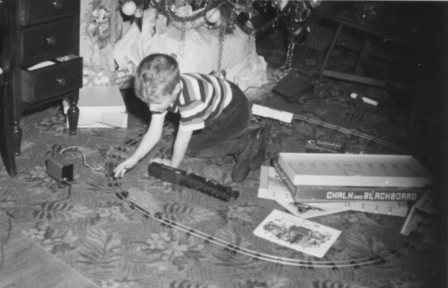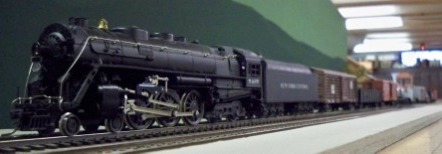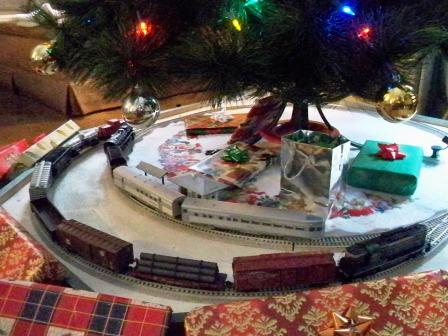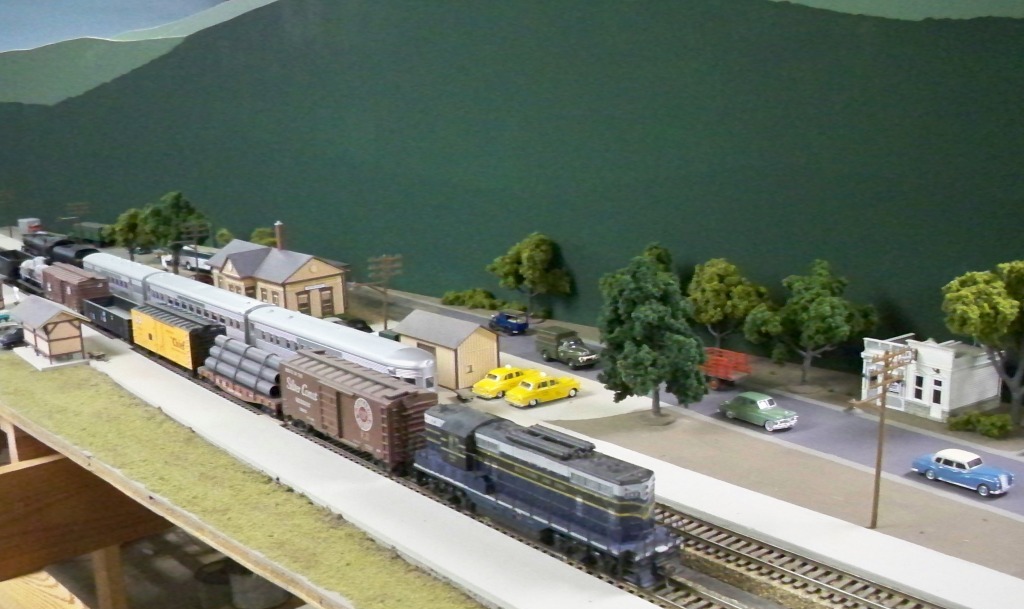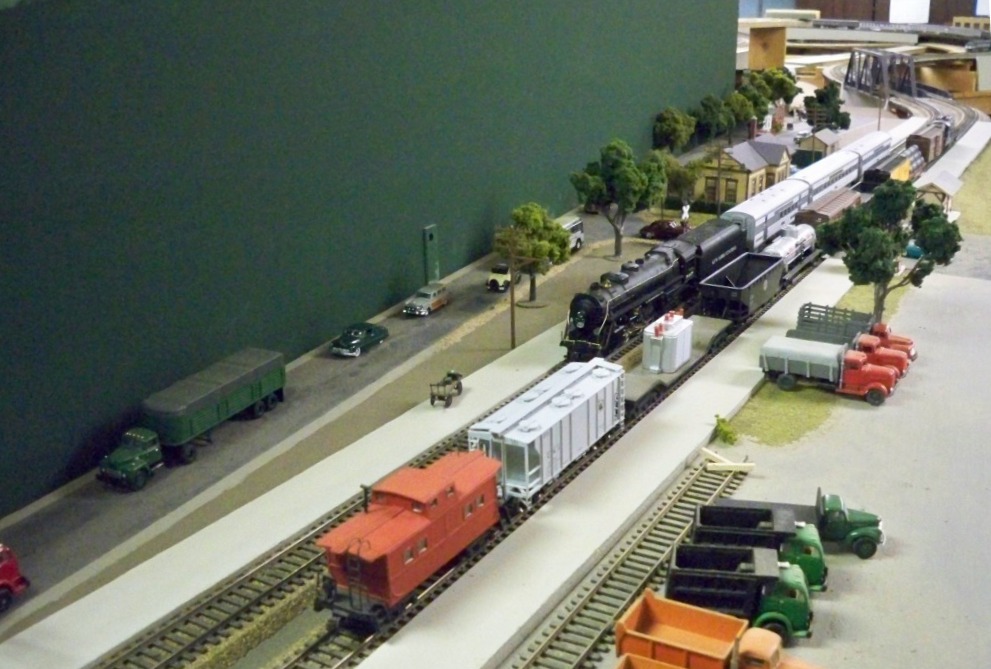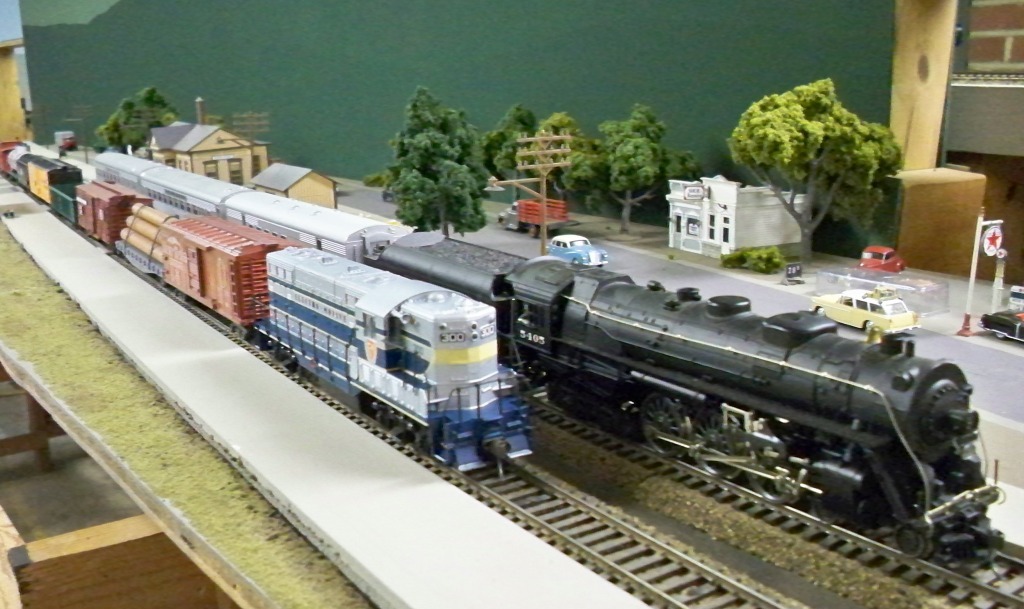THE FAUX FLYER FROLIC
My "American Flyer" Experience
Except where otherwise noted,
American Flyer S-gauge items displayed on this page were photographed by the
author at local model train shows.
We are grateful to other photographers and collectors whose work is displayed
here, and urge viewers to visit their outstanding websites.

If you've come to this page hoping to find information about luggage
or bicycle racing, sorry, it's not that kind of "American Flyer." If
you've wandered onto this page with no idea of what "American Flyer" has
signified in the minds and hearts of American kids since the 1930s through the
1960s, even until
well after these kids have grown old, think: "like Lionel trains—only different."
For more in-depth background, you might want to switch to the branch line to "Notes
on American Flyer Trains" near the bottom of this page before proceeding.
But if you've heard of A. C. Gilbert, if you know what "S-scale"
means, and if you can tell a Geep from a Hudson, you're clear and green to
highball down the main! ▼
Yes, I'm what you might call a serious modeler.
So what the heck am I
doing with these toys?
Well, once upon a time I was a kid.
And more than half a century later, part of that kid is still living happily
ever after.
It's like this...
ON THIS PAGE
I. The Fever Strikes at Yuletide
Real American Flyer, 1950-1960
Intermission
II. Circling the Tree Again
The "Hand-Me-Down" Phase, 2009-2010
III. The Yule Tree Vanishes
The "Prototypes" Phase, 2011-2012 (with video)
IV. A Shift of Perspective
The "Flyer Look-Alike" Phase, 2013
Outlook
Sites for Those Who Demand Genuine American Flyer
Notes on American
Flyer Trains
Episode I: The Fever Strikes at Yuletide
I got my first electric train set for Christmas
in 1950, when I was six. It was a basic American Flyer S-gauge set-up,
comprising a simple loop of track, a Reading #303 4-4-2 "Atlantic" type
locomotive and tender, two freight cars, and a caboose. "Wow, thanks,
Santa!" I probably got more mileage out of this than any other plaything
(with the possible exception of my phonograph) until I got my first bike.
The next year, a baggage car and a few coaches
showed up, and I had passenger service. Over successive Christmases and birthdays,
the loop of track expanded and moved to a permanent site in the basement, the
freight fleet expanded to nine cars, and VIP passengers could opt for
Pullman service in an open-platform observation car. Another
locomotive (Pennsylvania K-5 4-6-2 #313) and more coaches were acquired second-hand
from one of my dad's friends.
About the time I turned 10, we moved across town, and the train layout moved from the
basement of the old house to the attic of the new one. At age 11 or 12, I began riding my bike to the local railroad
yards to watch the real trains, and it occurred to me then that my
S-gauge toys
were rather crude-looking. Equipment available in smaller
HO scale
looked much more realistic, being both more accurately proportioned and better
detailed. So, in the early 1960s, I traded in the American Flyer and started
over in HO, and have been in that scale ever since.
Intermission
A four-year break in my model railroading pastime was imposed by my
enlistment in the army, during which a certain young lady and I met and
subsequently committed matrimony. After my discharge from the service,
we moved into an apartment for a few years until we'd saved enough to afford a
down payment on a house. The dwelling we chose was ideal. It had a
splendid 1,200-square-foot (110-square-meter) cellar, and was located just half a
city block from my
favorite hobby shop. (The above-ground part wasn't bad either.) In the
years since, a few layouts have been planned, partially built, and then
(except for the current layout) replaced when a new
concept occurred to me. A small, portable layout, also
in HO scale, was built to run under the Yule tree, ostensibly for the amusement of our daughter and our cat,
but also to satisfy my own nostalgic impulse.
Still, when I attended model train shows each fall, I felt drawn to the
American Flyer swap tables and operating layouts. There was still
something about that clunky toy stuff that claimed some child's corner of my
heart—and I'd like to think it wasn't just the sharp ozone smell from the old
open-frame motors! So, for a few years I entertained the idea of
acquiring some used Flyer equipment to replace the HO under-tree layout.
But there was always some reason to put it off—not the least of which being the
practical difficulty of locating parts for equipment that had been run to death by kids
and then stored for years in damp basements or dusty attics.
Episode II: Circling the Tree Again
Then it struck me. To get the American
Flyer ambience, I needn't buy (and refurbish and maintain) antique equipment,
or even switch the portable layout from HO to S gauge. I could simply
use HO models of the same engines and cars after which the Flyer toys had been
patterned. And when the little loop of track goes back into storage
after the winter holidays, any equipment that conforms to "model" quality can
continue in operation the rest of the year on the permanent layout in the
cellar. This being both the much less daunting and more affordable
option, I took the plunge.
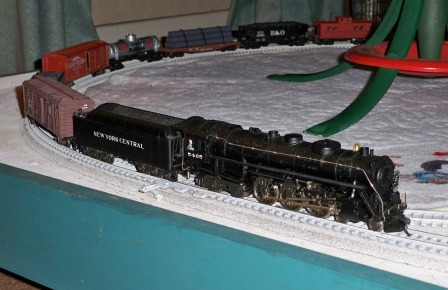
Hey, under the tree, this stuff could actually be mistaken for American Flyer
(or Lionel)—if you don't look too closely!
|
2011-2012: The "Prototypes" Phase
An upgraded fleet stretches its legs on the big cellar layout.
With the Faux Flyer equipment transplanted to an environment that's
both less hazardous and more brightly illuminated, it occurs to me that
this hodge-podge of cast-off cars might be replaced with better quality
models of the specific prototypes of Flyer equipment. I could, for
example, replace the Lionel-HO toy Michigan Central gondola with a
finely detailed Accurail model of the Texas and Pacific car modeled by
Flyer, but in prototype black rather than Flyer's coach green. And
that composite "Snickers" reefer has got to go. And I'd love to
lay my hands on a gray LNE hopper car, if I can find one. And, of
course, that now lone toy Seaboard box car will be way out of place with model
equipment. So...
|
| These
hand-me-downs... |
...are
replaced by these models of prototypes... |
...on which these S-gauge American Flyer cars were based. |

Gilbert-HO #514 box car; "Silver Meteor" SAL
(original,
toy, r-t-r) |

Roundhouse box car; "Silver Comet" SAL 38575
(original,
budget model, kit) |

AF
#642 / 942 Seaboard "Silver Meteor" box car |
|
I hadn't
used or photographed the Athearn
(budget model) flat car in its original
Canadian National livery. I'd simply relettered portions of the car for a CNW
prototype before building the kit, so, it was already in "prototypes" mode from the outset.
|

Athearn flat car, CNW 200339
(relettered,
budget model, kit) |

AF #628 / 928 Chicago & Northwestern "log car" 42597
(Photo:
http://www.thegilbertgallery.org) |

Lionel-Rivarossi gondola, MCRR 15317
(original,
toy, used) |

Accurail gondola; T&P 17834
(original,
high-grade model, kit) |

AF #631 / 931 Texas & Pacific gondola |

Athearn offset-side hopper, B&O 427971
(redecorated,
budget model, kit) |

Accurail offset-side hopper, LNE 13328
(original,
high-grade model, kit) |

AF
#632 Lehigh New England offset-side hopper car
(Photo:
http://www.thegilbertgallery.org) |

Athearn composite reefer, "Snickers" TMX 1068
(original,
budget model, r-t-r) |

Trainline plug-door reefer, "Chief" SFRD 3468
(redecorated,
budget model, used) |

AF #647 / 947 Northern Pacific plug-door refrigerator car |
|
I hadn't photographed
the Lionel-Rivarossi stock car in its original MKT "Katy" colors. And
in this time period, I know of no available model that closely resembles Flyer's
composite "cattle car" design. So for now, I simply give the toy a Mo-Pac prototype paint scheme and number.
|

Lionel-Rivarossi stock car; MP 53180
(redecorated,
toy, used). |

AF #629 / 929 Missouri Pacific "cattle car"
(Photo:
http://www.thegilbertgallery.org) |

Mantua tank car, "Mobilgas" SVX 1443
(original,
toy, r-t-r) |
At this stage, I've been unable to locate a car more closely
resembling Flyer's Gulf tanker, so I retain
Mantua's Mobilgas car. American Flyer did produce a Mobilgas tanker
(#958) in 1957, but it was red with white lettering,, not silver with
black.
|

AF #629 / 929 Gulf tank car GRCX 5016
(Photo:
http://www.thegilbertgallery.org) |

Varney caboose
(undecorated,
budget model, used) |
Though barely a decade less ancient then the
American Flyer car it represents, the Varney model is of acceptable model
quality. So it is retained as the prototype model for this car.
However, for the time being it remains unlettered, so that it can serve as
a backup any time there's a caboose shortage on any railroad in the house.
|

AF #630 Reading caboose
(Photo:
http://www.thegilbertgallery.org) |
|
2013: The "Flyer Look-Alike"
Phase
Everything
new is old again!
I
should point out that there are limits to this "look-alike" plan. A
car or locomotive already decorated and numbered for a desired prototype
is left as is. But when I redecorate
a car specifically for the Faux Flyer roster, in most cases I apply (as
nearly as I can duplicate them) Flyer's colors, road name, lettering, and numbering. Exceptions
include units representing S-gauge equipment lettered for "American
Flyer" or "American Flyer Lines," which are mostly locomotives and
passenger cars, as well as maintenance-of-way equipment (which I don't
include in my Faux Flyer roster). These are to be lettered for the prototype
railroad (if decals are available). As to numbers, locomotives
(of which there are only two) receive prototype numbers, but passenger cars
are numbered
according to Flyer's practice.
|
Locomotives
|
Despite that I never owned one, American Flyer's Hudson has a double appeal
for me. On Flyer's steam roster, it was a coveted prize, second only
to the stupendous Union Pacific class FEF-1 4-8-4 "Northern" type. The Hudson
also represented one of the real locomotives that daily charged through my
home town. And on a few occasions they faithfully hauled me home after
I'd been visiting my grandparents in Cincinnati, until the Central retired
the last of its steam power in 1956.

American Flyer #321 4-6-4 "Hudson" type, New York Central class J-3a
(Photo:
http://www.thegilbertgallery.org)

Rivarossi 4-6-4 "Hudson" type, New York Central class J-3a 5405
(original, low-grade model, used)
The Rivarossi Hudson wears its original paint and lettering,
except that the cylinder heads are changed from silver to black. I don't
think the engineer was standard equipment on this model. However, he
came with this pre-owned engine, and is welcome
to stay as long as he enjoys the job!
There were several variants
within the prototype New York Central's sub-class J-3a. The most
obvious of these were between streamlined or unstreamlined versions, and
between 14-wheel "centipede" or 12-wheel conventional tenders.
Additional options included Scullin-disk or Box-Pok type driving wheels,
and rectangular or cylindrical feedwater heaters. NYC's number 5405
was an unstreamlined engine with a 12-wheel tender, Box-Pok drivers, and a
cylindrical feedwater heater. This combination was the prototype for both
American Flyer and Rivarossi models.
|
The "Flyer look-alike" project poses a problem for my Baltimore & Ohio
GP-7. My research has revealed that American Flyer did not produce
any Geeps in B&O paint. So, since I'll sometimes be running it
on the big B&O layout in the cellar, I need to find a road name in which
Flyer produced its Geep that might credibly be found on B&O rails during
the early 1950s. Looking at the target production years of 1950 through 1957,
I find that Flyer's Geep was produced in Chesapeake & Ohio, Texas &
Pacific, and Union Pacific road names. The T&P and UP were western
roads completely outside B&O territory. And the C&O, though it was
in B&O's area, was also a bitter rival, and not likely to be sharing
trackage with B&O except in limited interchange service. This leaves one
possibility: the Electro-Motive GP-7 demonstrator, the first color scheme
in which Flyer offered its Geep when it was brand new. GM had
produced three GP-7 demonstrator units, numbered 100, 200, and 300, which toured many
American railroads between 1950 and 1954, the B&O probably among
them.
|
American Flyer had a reputation for
good quality modeling (by the standards of the day). In 1950, the company
introduced models of two new diesel locomotives: an Alco PA- PB set that lived up
to this reputation, and an EMD GP-7 that did not.
Aesthetically, Flyer's GP-7
was horribly botched, starting with the trucks, whose gross oversize might
have been attributable to mechanisms borrowed from the larger Alcos.
From this key error of geometry, there ensued a cascade of other errors in
an apparently panicked attempt to compensate. And to add insult to
injury, Flyer's paint scheme was a crudely stingy reduction of the
prototype's strikingly handsome markings.
Still, these units performed
well, and in the 1950s Flyer sold a fair
number of them to an uncritical consumer base, to whom Geeps were a
brand new and thus not yet familiar phenomenon. Flyer's early GM
units were typically included in short work-train sets; the later C&O, UP,
and T&P units were packaged with military and freight train sets of up to
six cars.

American Flyer #370 EMD GP-7, General Motors demonstrator

Athearn EMD GP-7 demonstrator, GM 300
(modified, redecorated, budget model,
r-t-r)
For this project, my old B&O
Geep is de-modified from passenger
service, and directional LED headlights are installed. Added
details, color scheme, and numbering conform to the prototype GM 300.
Athearn's GP-7 suffers from
the distraction of a slightly wider than scale hood, necessary to accommodate the
open-frame HO motors of the 1950s. The result is that the Athearn
unit's "chisel-nose" ends have a curiously blunt appearance. But this minor deformity is
insignificant compared to Flyer's bungled attempt to replicate EMD's
then-newest product. So, in this case, the "Flyer look-alike" effort is
set aside, in order to create a model that looks, not like Flyer's, but as
Flyer's should have looked.
Paint: Polly Scale flat
aluminum; Modelflex B&O royal blue
Decals: Microscale 87-1003
|
|
Passenger Cars
|
Athearn's HO streamlined
passenger cars provide a visually pleasing and adequate, if less than
perfect, match to American Flyer's four-car streamliner set.
Compromises include the following:
-
Athearn does not offer a
streamlined baggage-club combine, so I've substituted a postal car as an
aesthetic stand-in with a similar window-and-door pattern.
-
I initially resisted the
temptation to run a vista-dome car behind the Hudson, since, like most
eastern U.S. railroads in the 1950s, the real NYC didn't operate domes.
However, since the Flyer look-alike scheme now rules, I've relented.
-
American Flyer's early streamliners
were all lettered for American Flyer Lines. There being no "American
Flyer" decals in HO scale, I've chosen to letter the Faux Flyer passenger
fleet for New York Central (corresponding to the Hudson loco), but have
applied American Flyer's car numbers.
All coupled up and hitched to
the Hudson, this four-car streamlined set makes a nice approximation of
American Flyer's Pacemaker passenger set K5351W, introduced in
1953.
|
| These Faux
Flyer HO models... |
...represent these American Flyer S-scale items. |
|

Athearn streamlined 60' RPO (railway post office) car, NYC 660
(decaled, budget model, used)
|

AF #660 streamlined baggage-club combine "Columbus"
(Photo:
http://www.thegilbertgallery.org) |

Athearn streamlined 70' coach, NYC 661
(decaled, budget model, used)
|

AF #661 streamlined coach "Jefferson"
(Photo:
http://www.thegilbertgallery.org) |

Athearn streamlined 70' vista dome car, NYC 662
(decaled, budget model, used)
|

AF #662 streamlined vista dome car "Hamilton"
(Photo:
http://www.thegilbertgallery.org) |

Athearn streamlined 70' observation car, NYC 663
(decaled, budget model, used)
Decals: Microscale 87-1352 (all streamlined
passenger cars) |

AF #663 streamlined observation car "Washington"
(Photo:
http://www.thegilbertgallery.org)
|
Freight Cars
|
| These Faux
Flyer HO models... |
...represent these American Flyer S-scale items. |
|
The following" two units were manufactured either by or for Gilbert-HO, and
are used without modification, except for installation of Kadee
magnetic couplers for operational compatibility.
|
|

Gilbert-HO #514 40' steel box car, SAL 514 "Silver Meteor"
(original, low-grade toy, r-t-r)
Its conspicuous crudeness (e.g., grossly
oversize door rails, lack of corner steps,etc.), compared to other Faux
Flyer equipment, might eventually send this Gilbert-HO car back to the
discard bin, now that a more compatible (B&O) box car has been finished. |

AF #642 / 942 Seaboard "Silver Meteor" box car
Except for the difference in roof-walk design
(metal grid on the HO car, wood-plank on the S), car numbers, and of course
their actual sizes, the superstructures of these Gilbert box cars are
otherwise virtually identical—right down to the
weird "missing middle" rivet patterns in the side panels to the left of the
door, |

Gilbert-Varney #500 36' tank car, GRCX 5016 "Gulf"
(original, budget model, used)
Note that the Gilbert-Varney HO car has black
tank ends, dome cap, ladders, and handrails, whereas these components on the
American Flyer S-gauge car are the same aluminum color as the rest of the tank. |

AF #625 / 925 Gulf tank car, GRCX 5016
(Photo:
http://www.thegilbertgallery.org)
The Gulf tank car was one of the few American
Flyer cars that displayed both a prototype car number and Gilbert's unit
number. As far as I know, no prototype Gulf tank cars were ever
painted aluminum; most, if not all, were black. |
|
The following HO models have been selected to resemble American Flyer S
equipment, and redecorated in Flyer's (in some instances non-prototypical)
paint schemes and with Flyer's unit numbers.
|
|

Train Miniatures 40' box car, B&O 633
(redecorated, budget model, kit)
This unusual ARA car, with Youngstown doors and
Dreadnaught ends, is reasonably similar to the American Flyer box car.
However, since there was no prototype for the
brown-over-white paint scheme on the real Baltimore & Ohio, it took a while
to find an appropriate set of decals for it. Consequently, this was
the last freight car added to the Faux Flyer roster.
Paint: Polly Scale light freight car red;
Modelflex antique white
Decals: Champ HN-99; Microscale 87-2 |

AF #633-w / 933-w Baltimore & Ohio box car
(AF also produced a #633-r B&O box car in red with white lettering.)
(Photo:
http://www.thegilbertgallery.org)
Although this car resembles some of the ARA box
cars run by the real B&O, the prototype box cars were typically painted in
varying shades of oxide red with white lettering, or in a few cases in the
flashy Sentinel and Time-Saver schemes—never in brown-over-white. This
color scheme was entirely concocted by the toymaker. It was also
skimpy on markings: no reporting marks or loading data. |

Athearn 40' flat car with log load, C&NW 42597
(redecorated, budget model, kit)
Paint: Polly Scale CSX gray
Decals: Microscale 90002 |

AF #628 Chicago & Northwestern "log car" 42597
(Photo:
http://www.thegilbertgallery.org)
The CNW flat car was one of a few cars that
displayed prototype car numbers instead of American Flyer unit numbers.
It displayed little else, aside from reporting marks. Prototype CNW
flat cars were oxide red with white lettering. (That they ever hauled
stained wooden dowels is probably as fictitious as the gray color.) |

Mantua 40' 11-panel gondola, T&P 931
(redecorated, budget model, used)
Paint: Polly Scale sylvan green + engine black
mix
Decals: Microscale 87-183, 90051, 91111 |

AF #631 / 931 Texas & Pacific gondola
Prototype T&P gondolas were painted black with
white lettering. The dark green was the toymaker's choice, presumably
to add a bit more seasonal color to Christmas-tree displays. Flyer at
least saw fit to print loading data on this car. |

Athearn 34' 2-bay offset-side hopper, B&O 801, with coal load
(redecorated, budget model, kit)
Paint: Floquil engine black
Decals: Champ HC-77 |

AF #801 Baltimore & Ohio hopper car
(Photo:
http://www.thegilbertgallery.org)
|

Trainline 40' plug-door refrigerator car, NP 647 "Main Street of the
Northwest"
(redecorated, budget model, used)
Paint: Polly Scale light freight car red;
Modelflex UP armor yellow + reefer orange mix
Decals: Microscale 87-488 |

AF #647 / 947 Northern Pacific refrigerator car
The NP reefer was, to my eyes, one of the most
strikingly good looking cars in American Flyer's early freight fleet.
I never owned one. But now I have an HO look-alike.
|

Trainline 40' composite stock car, MP 929
(redecorated, high-grade model, r-t-r)
This is the only high-grade model in the Faux
Flyer fleet, since it was the only model available that conformed acceptably
to Gilbert's design—never mind that the diagonal bracing goes in the
opposite direction!
Paint: Polly Scale mineral red +
caboose red mix
Decals: Microscale 87-189; Westerfield 8801 |

AF #629 / 929 Missouri Pacific "cattle car"
(Photo:
http://www.thegilbertgallery.org)
An early version of the Flyer stock car had
prototypical slots in the sides, whereas the only open slots on this one are
in the doors. My guess is that the manufacturer decided to close the
slots, either because slotting increased production costs, or because a
slotted body didn't have enough strength to withstand use as a toy. |

Varney centered-cupola steel caboose, RDG 630
(redecorated, budget model, used)
The faithful old caboose now has updated paint,
lettering, and interior lighting.
Paint: Polly Scale caboose red,
armour yellow
Decals: Microscale 87-883 |

AF #630 Reading caboose
(Photo:
http://www.thegilbertgallery.org)
|
Most early American Flyer equipment was lettered in a uniform
G O T H I C font, even though most prototype railroads
of the time used
R O M A N
lettering. In decorating the Faux Flyer equipment, I've used
prototype lettering styles, since they're what's available to modelers of
prototype equipment.
|
Additional Equipment
|
|
My cellar layout has numerous
pieces of equipment which, while not exact matches to American Flyer units,
are sufficiently similar to preserve the effect. While there's no room
for them on the Yule-tree layout, they can be added to double the length of
the basic eight-car freight train when it's running on the big layout.
With only half of its wheels powered, Flyer's Geep would have struggled to
move a nine-car train (considering Flyer axle bearings were not the
low-friction needle-point type common in HO), but my Athearn GP-7, with all eight
wheels powered, can haul a longer train with confident ease. |
 
Erie 7268 with transformer load fills in for Flyer's 12-wheel
depressed-center flat car 7210 (#636 / 936) with wire reel load.
(The flat-side design of the Flyer car is actually closer to the Erie
prototype; to my knowledge, there are no HO models of the Erie 7200 series
cars.)


Central of New Jersey PS-2 covered hopper subs for Flyer's #624 / 924
"cement car," a stock offset-side hopper with hatch roof added.
(Although installing hatch roofs on outside-braced hopper cars was
fairly common back in the days when covered hoppers were still experimental,
the structurally weaker offset-side design was seldom if ever used for
cement, which is denser than coal. Thus, I'm reasonably certain Flyer's offset-side kluge had no real-world prototype—which
would explain why there are no commercially available HO-scale models of
such a car.)


Lehigh & New England hopper 13328 shows up Flyer's gray #632.


Chesapeake & Ohio gondola 36002 does a capable impression of Flyer's
#911.
(I might eventually add a pipe load.)


Great Northern box car 50324 does the latest decaled version of Flyer's #913
proud.
(Earlier versions of the Flyer car had a monochrome version of the
herald painted on.)
(Photos of untagged American Flyer items [right]:
http://www.thegilbertgallery.org)
In 1956 and 1957, American Flyer
added several new road names and colorful paint schemes to its existing car fleet.
Some of these find close approximations in my model roster, which can be
temporarily pressed into Faux Flyer holiday service on the cellar layout.
Among these are:
AF #980 Baltimore & Ohio
"Time-Saver" box car (blue and orange)
AF #982 Bangor & Aroostook
"State of Maine Products" box car (blue, white, and red)
AF #984 New Haven "NH" box car
(vermillion)
AF #989 Chicago &
Northwestern refrigerator car (green and yellow)
In 1958, American Flyer switched
from its long-standing three-digit numbering practice to a five-digit
scheme, which looked vaguely more realistic, but still did not use actual
prototype car numbers. By this time, however, I was looking to replace my
American Flyer equipment with HO scale, so this is the cut-off point
for my Faux Flyer effort. |
Outlook
The "Faux Flyer Frolic" is a
holiday diversion.
My main model railroading interest still lies in the big cellar layout, which is
still in a discouragingly underdeveloped state, in serious need of buildings, scenery, and
circuitry of all sorts, plus from-the-ground-up construction of a
point-to-point branch line for a
more hands-on operating experience than the dual-track mainline loop allows. But that's the fun of a hobby
like this one. There's no hurry, no schedule—unless you choose to
operate on a timetable or hold yourself to project deadlines. You do whatever you want to do, whenever you
feel like doing it (and can afford it). You can sidetrack your main
operation at any time for as long as you like, in order to indulge a whim or
fancy (or even work). No one will holler at you or dock your pay. After all, a
hobby is supposed to be a fun, leisure activity—not a second job!
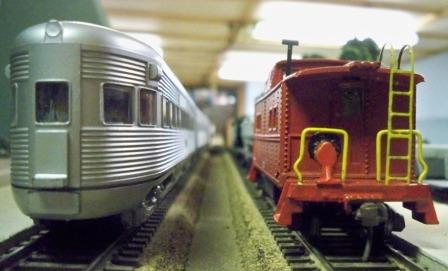
Sites
for Those Who Demand Genuine American Flyer
American Flyer Club
American Flyer Displays
The Gilbert Gallery
My Flyer Trains
(Chuck)
Notes on American Flyer
Trains
The
"American Flyer" Name: In recent years, the name "American Flyer"
has been associated with such things as a line of luggage and a film
about bicycle racing. But in the mid-twentieth century, it was the brand name of a line of miniature electric trains
manufactured by the A. C. Gilbert Company of New Haven, Connecticut, from the
1930s until the 1960s, in competition with the more widely known Lionel
Corporation. Gilbert also produced other "educational" youth items, such
as microscopes, chemistry sets, a planetarium projector, and the famous "Erector" sets.
Early Evolution of the Product: The earliest American Flyer trains were
"tin-plate" toys that operated on nominally O-gauge three-rail track.
(True O-scale is a 1:48 linear size-reduction ratio of the model with respect
to the prototype. Thus, the 56.5-inch between-rail spacing of real
standard-gauge track works out to just under 1 3/16
inches in O scale. However, the toy industry standard was set at 1 1/4
inches, which is closer to a 1:45 reduction ratio. This makes
higher-ratio models that run on such track look curiously undersize and
"squatty.") American Flyer's earliest scale models from the late 1930s
used a 1:64 size-reduction ratio, designated S-scale, but with running-gear
mechanics adjusted to operate on readily available O-gauge track—so they
looked even "squattier" than O-scale equipment. But no one cared.
It was "just toys." And in the wake of the Great Depression, any kid
whose family could afford to buy him an electric train set felt damned lucky,
and had no grounds for complaint over the aesthetic imperfections of "toys."
War
Years: World War II put many toymakers, including American Flyer,
out of operation "for the duration," because critical materials and manpower
needed for all-out wartime production could not be spared even for cars and
appliances, let alone toys. During the war years, Gilbert continued to
produce company literature, not to market toys, but rather as a public service
to promote awareness of the wartime need for watchful citizens (including
responsible children) to help safeguard the safety and security of industry in
general, and of railroads in particular.
Postwar: When Gilbert resumed production of electric trains in 1946,
the product line made a dramatic shift. Oh, it was still S-scale (3/16
inch on the model equivalent to 1 foot on the prototype), and still ran on
low-voltage electric current. But whereas the company's pre-war toy
trains had been set up to operate on three-rail O-gauge track (1 1/4
inches between the outside rails), their post-war descendants would operate on
two-rail S-gauge track (about 7/8 inch between the
rails), thus finally matching the scale of the track to that of
Flyer's rolling equipment, for a uniform linear size reduction ratio of 1:64,
and thus far more consistent and realistic proportions. Obviously,
pre-war and post-war equipment were incompatible; the two couldn't operate on
the same track. However, after a four-year hiatus in the business, there
was a new market to be served, a market that included not only young boys, but
also their dads home from military service. This new, more critical
market wanted miniature trains to look, not like crude toys, but like real
trains, only smaller. And American Flyer filled the bill.
First, the two-rail, scale-width track looked more like what real trains run
on. Second, phasing out clunky tinplate toys in favor of die-cast equipment
improved quality, precision, and durability.
Third, the equipment was modeled
after specific contemporary real-world prototypes—New York Central's class J-3
Hudson (4-6-4) type locomotive, Pennsylvania's class K-5 Pacific (4-6-2) type,
Union Pacific's class FEF-1 Northern (4-8-4) type, and so on, with all pumps,
pipes, tanks, domes, rods, lights, bells, and whistles the right size and in
the right place. The result was that American Flyer models actually
looked much more like real railroad equipment than did their competition from
Lionel. A kid who had an American Flyer train could spot a real
locomotive or car at a local railroad crossing and proudly cry out, Hey,
that one's just like mine!
(Though
Lionel also built a few scale models for a limited adult collector market, its
mainstay continued to be crude but durable toys that ran on
three-rail toy track, and whose resemblance to real railroad equipment was
most charitably characterized as nondescript.)
Diesel and Electric Locomotives: In 1950, American Flyer introduced its
first models of diesel-electric locomotives. One was a sleek Alco PA and PB
set decked out in Santa Fe's eye-grabbing silver, red, yellow, and black
war-bonnet paint scheme. The other was an Electro-Motive (General
Motors) GP-7 "road switcher" in simplified
demonstrator attire. The Alco units were decently done replicas of the
real thing. The Geep, apparently done "on the cheap," was, to
put it mildly, an
aesthetic disappointment, with inappropriately sized mechanics borrowed from the Alcos,
and other dimensions fudged to compensate. But such difficulties notwithstanding, all of these diesel units
were later produced in paint schemes of other railroads, some real and some
fictitious. Later in the 1950s, Flyer produced a credible model of General
Electric's EP-5 electric loco in black, red, and white New Haven livery.
Still later, it produced a Baldwin diesel switcher decorated for Chicago and
North Western.
Numbering Schemes: For the most part, Gilbert did not use prototype numbers on its
locomotives or cars, but rather marked equipment with Flyer's own three-digit
item numbers. Locomotives were numbered in the 200-399 series, and
freight and passenger cars were assigned numbers in the 600-699 range.
Action cars were assigned to the 700-799 series. There were a few
exceptions: the #628 C&NW flat car sported car number 42597; the #636 Erie
depressed-center flat car bore number 7210 from its prototype's numbering
series, but had its
Flyer item number printed on its cable-reel load; and the
#625 Gulf tank car bore car number 5016 in addition to its Flyer item number.
Here's
where things go from slightly confusing to really complicated. In
1953, American Flyer discontinued its old link-style coupler, replacing it with a more
reliable and somewhat more realistic (but grossly oversize) "knuckle" coupler
(similar to Lionel's).
The old and new coupler types were mutually incompatible, so Flyer changed the
numbers for new freight and passenger cars to the 900-999 series.
Thus, the link-coupler-equipped #631 T&P green gondola of 1952 was succeeded by the knuckle-coupler
#931 T&P green gondola of 1953, and so forth. Likewise, new action cars with knuckle couplers were
assigned to the new 800-899 series, and the 600-699 and 700-799
link-coupler series were discontinued. Locomotives remained in their
original numbering series, but the "units" digits of their numbers changed to
indicate the new coupler type, as well as other features (such as AC or DC
operation, puffing smoke, "diesel roar," and the like). In
addition, the numbering series for locomotives
was expanded to 499, as new road names for diesel equipment came on line.
However, it's common to find older Flyer equipment bearing pre-1953
numbers sporting knuckle couplers, because Flyer marketed conversion couplers
to update older equipment.
In 1958, all equipment numbers for
S-gauge American Flyer were changed to a five-digit format. To my knowledge,
unlike the coupler changeover, there was no technological advance spurring
this change. It appears to have resulted simply from running out of
three-digit numbers for all the new road names. (I haven't bothered to
research the five-digit format, since it's outside the era that I'm replicating.)
Gilbert HO: In addition to American Flyer S-scale trains, A. C. Gilbert also produced the Gilbert HO line of toy-quality trains in
1:87 scale,
from the 1930s until the 1960s. Most items in this relatively meager
line were assigned to the 500-599 series. Gilbert
initially produced all of its own equipment. But toward the end,
production was outsourced to other HO manufacturers, such as Varney—ironically
with significantly improved looks of the product. But it was the classic
story of "too little too late." Gilbert HO had acquired the "toy" stigma
over decades, and one or two years of model-quality output could
not erase it.
▲
RETURN TO THE TOP OF THIS PAGE

